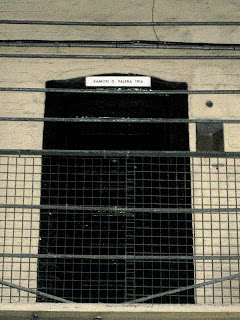Since I arrived in Dublin, Kilmainham Goal has been the one thing I've desperately wanted to see above any other 'attraction' in the city. I decided to wait and go with someone who could share in both my interest, but also understand the heaviness and emotion that coincides with an experience like this. Mommy was the perfect person to bring with me on this haunting and emotional journey through the walls of the goal and we each came out at the end feeling quite saturated in this part of Irish history.
Kilmainham Goal was, among other things, used to imprison the 14 leaders of the 1916 Easter Rising after they were captured by the British forces. They were held at the goal until they each met their execution dates in May of 1916.
I really can't describe the feeling you get while walking through the halls, it's both nerve wracking and exhilarating at the same time. I got the shivers more than once and I'm not kidding you when I say that there are ghosts built into the walls.
We started our tour in the chapel. This was the setting for the marriage of Joseph Plunkett to his fiance Grace Gifford just hours before his execution. They were married and then Grace was forced to leave the goal, only to return about 10 minutes before her new husband faced the firing squad.
The names of various prisoners are etched into the concrete.
"Beware of the Risen People, that have harried and held ye, that have bullied and bribed."
The 1916 ward.
These are the cells where the leaders of the rising were held.
May 4th.
Countess Markievicz
escaped execution because she was a woman - she wasn't particularly happy about this reprieve
Patrick Pearse.
May 3rd
Robert Emmet.
Entering Charles Stuart Parnell's Cell.
The largest and most lavishly furnished, Parnell was able to bring in his own furnishings and on a few occasions even order in food from his favourite pubs.
His view out into the hallway of the prison.
Entering the main ward.
I know they're in a prison, but I had a fascination with these stairs.
Eamon de Valera, was part of the 1916 rising, although not a leader. Later de Valera became the first President of the Irish Free State, fought in the Irish War of Independence and was a key figure in the civil war that ran from 1922-1923.
Grace Gifford's cell. Grace was the wife of Joseph Plunkett who I mentioned above. 7 years after her husbands death, Grace was imprisoned in Kilmainham for her involvement in the civil war. She fought on the anti-treaty side, claiming that her husband hadn't lost his life for half promises of Irish Independence. She painted this mural in her cell, a depiction of Madonna and child.
The exercise yard.
Next we were led into the courtyard where the 14 leaders of the rising were executed.
You can't imagine the emotions.
The Irish flag - green to represent the Nationalists and their ties to Ireland, Orange to reflect the Unionist ties to Britain, white in the middle to represent peace and unity of both sides.
The prisoners were placed in front of this cross, blindfolded with hands tied behind their backs to face the firing squad.
On the opposite side of the courtyard lies another cross. This is where the last leader of the rising, James Connolly was executed. He'd been shot three times during the fighting and was held at the Royal Victoria hospital wing at Dublin Castle where he was being treated for gang green. When he execution date came up he couldn't walk and was brought to the prison by ambulance that came through the gates to the right of the picture. He was tied to a chair and blindfolded and shot. This last execution came with an outcry from the Irish public who saw the act as heinous and disrespectful. The leaders, who were at first condemned by the Irish public were revered as martyrs after their executions because of the way the British chose to punish them. The executions were dragged out over several days, the number of prisoners executed changing with each day.























































No comments:
Post a Comment